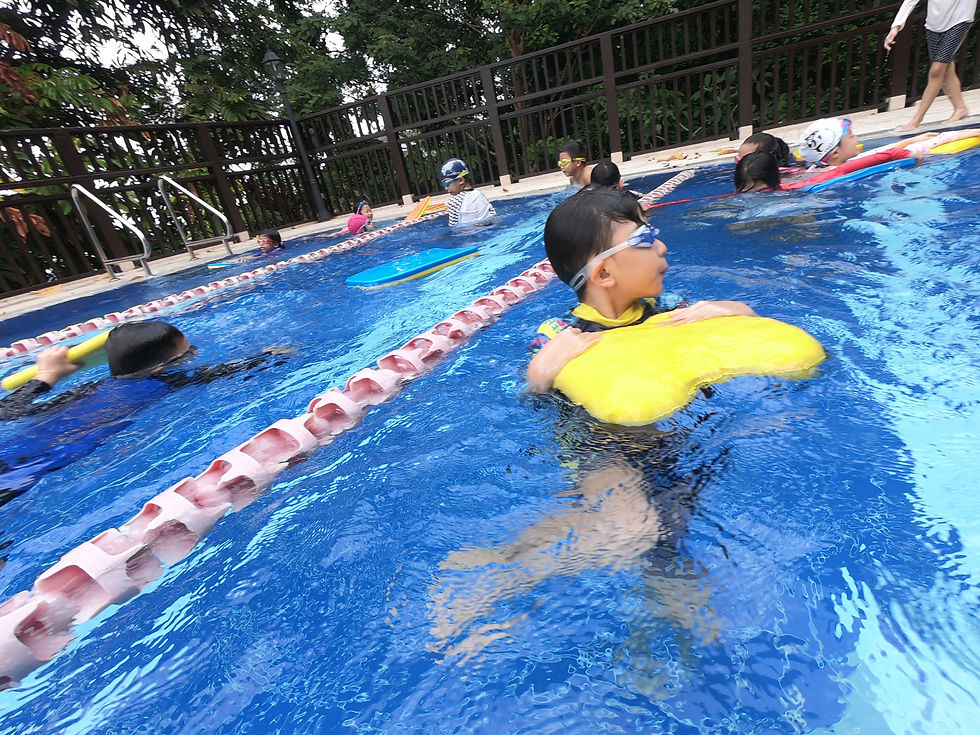Tips for Transitioning from Pool to Open Water Swimming
- SG Sink Or Swim

- Apr 18
- 3 min read

Swimming in a pool and swimming in open water are two very different experiences. While pool swimming offers a controlled, familiar environment with lane lines and walls, open water introduces a range of new challenges — from changing conditions and navigation to temperature and mental preparation.
Whether you're training for a triathlon, your first open water race, or just want to expand your swimming adventures, this guide will walk you through essential tips for transitioning from pool to open water swimming smoothly and safely.
🌊 What Makes Open Water Different?
Before diving into tips, it’s important to understand the key differences:
No walls or lane lines – no flip turns, no visual guides
Changing water conditions – currents, waves, tides, temperature shifts
Unpredictable visibility – murky or dark water can impact navigation
Psychological factors – fear of open space, depth, and marine life
No structured rest – swimmers must pace themselves without pauses
Being aware of these contrasts helps you mentally and physically prepare for open water success.
🧠 10 Key Tips for a Smooth Transition to Open Water Swimming
1. Start in Calm Water Conditions
Choose a safe, sheltered location like:
A lake with calm waters
A bay or ocean inlet on a clear day
Areas with lifeguards and marked swim zones
✅ Begin your open water journey in low-risk environments before tackling waves or currents.
2. Practice Sighting Techniques
Sighting helps you swim straight when there are no lane lines.
How to sight:
Every 4–6 strokes, lift your head briefly forward (just enough to see ahead)
Combine with a breath to minimize disruption to your rhythm
Use fixed landmarks like trees, buoys, or buildings
✅ Good sighting keeps you on course and conserves energy.
3. Work on Pacing Without the Wall
Without flip turns or pace clocks, it's easy to go too fast or too slow.
Tips:
Use a waterproof watch to track time or heart rate
Practice swimming steady 500–1000m sets without stopping
Learn to swim by feel (rate of perceived exertion)
✅ Developing self-pacing is crucial for endurance in open water.
4. Train with a Swim Buoy
A swim buoy improves safety and visibility.
Attach around your waist; it floats behind you
Provides flotation if you need to rest
Makes you more visible to boats and lifeguards
✅ A must-have for solo training or beginner open water swimmers.
5. Acclimate to Cold Water Gradually
Open water is often colder than the pool.
How to adjust:
Start with short swims and gradually increase time in cold water
Wear a wetsuit or thermal swim cap if needed
Practice deep breathing to stay calm and reduce cold water shock
✅ Temperature adaptation is key to physical comfort and safety.
6. Practice in a Wetsuit Before Race Day
If you plan to race in a wetsuit, get used to the feel in advance.
Wetsuits add buoyancy but can change your stroke mechanics
Practice entries, exits, and stroke adjustments
Rinse and dry wetsuits properly to preserve elasticity
✅ Don’t let your race day be the first time you wear your suit.
7. Get Comfortable with Open Water Starts
Open water races often begin with group water entries.
Practice:
Deep water treading starts
Beach sprint starts with dolphin dives
Managing physical contact in close proximity
✅ Start practice builds confidence and reduces panic under pressure.
8. Train with Others
Swimming with a group is safer and more motivating.
Join local open water swim clubs
Pair up with a swim buddy
Rotate who leads to simulate drafting and pacing
✅ Group swims mimic real race conditions and offer accountability.
9. Learn to Manage Mental Challenges
Open water can feel overwhelming — especially for beginners.
Tips:
Use positive self-talk to stay calm
Focus on your breathing and stroke rhythm
Break your swim into smaller mental checkpoints (e.g., to the next buoy)
✅ Mental toughness is as important as physical training.
10. Transfer Pool Skills to Open Water
Many pool drills and techniques still apply — adapt them creatively:
Practice long, uninterrupted swims
Do sighting every few laps in the pool
Use swim bands or tether cords to simulate continuous effort
✅ Your pool foundation supports your open water success.
🏁 Final Thoughts
Transitioning from pool to open water swimming is both challenging and incredibly rewarding. By adapting your training, learning new techniques, and preparing mentally, you'll gain the confidence and skills to swim farther, faster, and more fearlessly in natural waters.
With each open water swim, you'll unlock a deeper connection with the environment — and yourself.





Comments